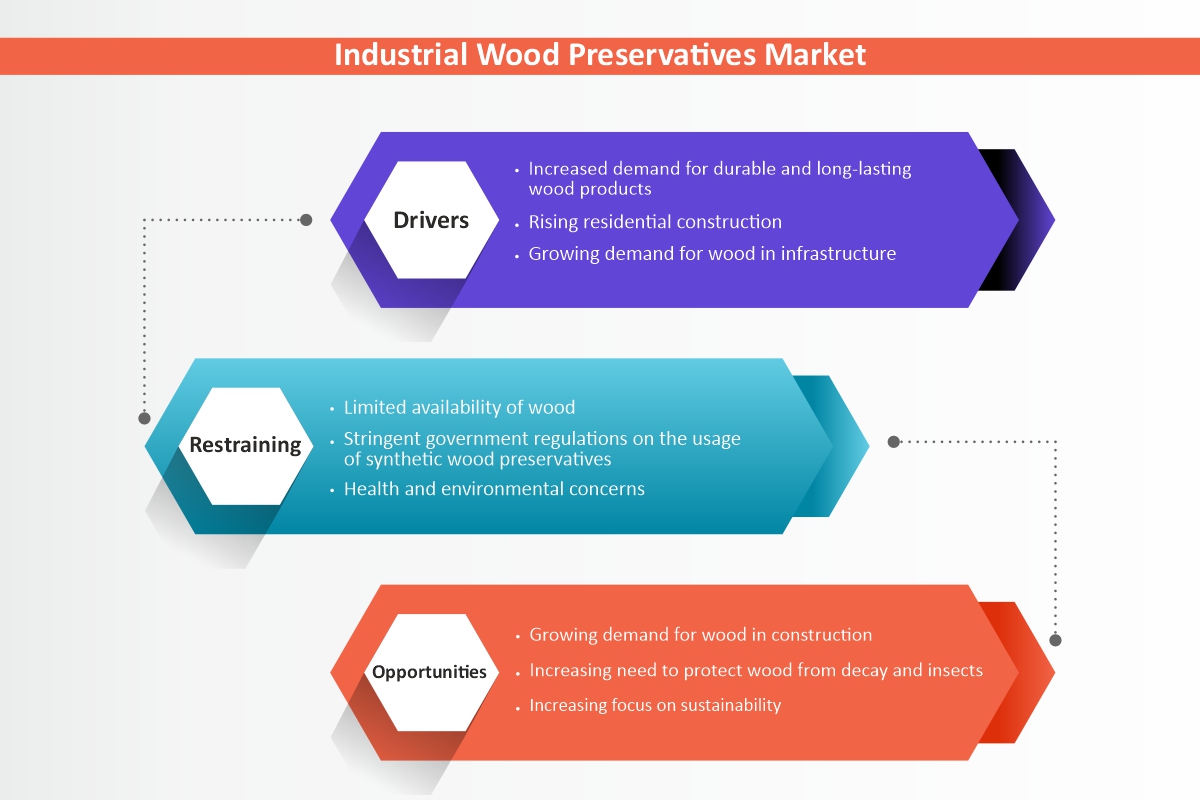Description
Global Industrial Wood Preservatives Market Size was worth USD 1.85 Billion in 2023 and it is expected to grow to USD 3.80 Billion in 2030 with a CAGR of 5.30 % in the 2023-2030 period.
Global Industrial Wood Preservatives Market: Overview
Wood is an integral part of a building, and is used in the making of furniture, doors, and floors. Thus, its preservation is a contemporary concern that increases the need for wood storage. In pressure treatment, the wood is placed in an airtight metal slide to protect it from insects, weather conditions, and corrosion. The preservation of wood improves the health of wood fall through the use of pesticides. Wood preservative material refers to many chemicals such as copper-based chemicals and oil coating. Each wood preservative has its own unique properties and should therefore be used in terms of its properties and ability to adapt to different environmental conditions. Preservatives such as copper azoles, synthetic pyrethroids, and creosote preserve and prevent wood from breaking and decaying, and provide longer life, thereby increasing its durability. There are many applications of wood preservatives that can be classified as commercial, industrial, and domestic. Commercial uses include fencing, railway products, public infrastructure, and decorative operations. Wood preservation is a form of compression where the wood is placed in a stainless steel enclosure to protect it from pests, weather, and debris. The preservation of wood improves the health of wood through the use of pesticides. Reinvesting income and rapid urbanization are key factors driving the growth of this market. However, introduction of advanced wood preservatives is accelerating the market growth. Improvement in living standards, increase in commercial real estate, and increase in industrial construction contribute toward the market growth.
Global Industrial Wood Preservatives Market: Covid 19 Impact:
The COVID-19 pandemic moderately impacted the market in 2020. However, it now returned to pre-pandemic levels and is expected to grow steadily. Over the medium term, the factors driving the market’s growth are the increasing demand for wood in different applications and the increasing furniture production. On the other hand, the stringent government regulations on various wood preservatives may act as barriers to the market’s growth. Developing eco-friendly wood preservatives will likely offer new growth opportunities to the industry. North America dominates the market studied, with the highest consumption recorded by the United States and Canada. Owing to the lockdown implemented across various countries, national and international transport have been hampered, which has significantly impacted the supply chain of numerous industries across the globe, thereby increasing the supply–demand gap. Thus, insufficiency in raw material supply is expected to hamper the production rate of wood preservatives, which negatively impact the market growth. However, this situation is expected to improve as government has started relaxing norms around the world for resuming business activities.
Global Industrial Wood Preservatives Market: Key Insights
- This growth is being driven by a number of factors, including increasing urbanization, rising demand for wood in construction, and growing awareness of the benefits of wood preservatives.
- The stringent regulations regarding the use of wood preservatives are also impacting the market. These regulations are designed to protect human health and the environment.
- Based on Type segmentation, Water-based wood preservatives are the most popular type of wood preservative, accounting for over 50% of the market. This is because water-based preservatives are less toxic and more environmentally friendly than oil-based preservatives.
- Based on Application, the construction industry is the largest end-use sector for industrial wood preservatives, accounting for over 60% of the market. This is because wood is a popular material for construction, and wood preservatives are essential for protecting wood from decay and insects.
- Based on region, it is projected that North America will continue to dominate the Global Industrial Wood Preservatives Market throughout the forecast period.
Global Industrial Wood Preservatives Market: Growth Drivers

Increased demand for durable and long-lasting wood products: Wood is a versatile and renewable resource that is widely used in construction, furniture, and other applications. However, wood is susceptible to degradation from insects, fungi, and moisture. Wood preservatives are chemicals that are applied to wood to protect it from these threats and extend its lifespan. As demand for durable and long-lasting wood products increases, so does demand for wood preservatives.
Rising residential construction: The global construction industry is expected to grow steadily in the coming years, driven by factors such as population growth, urbanization, and rising disposable incomes. Residential construction is a major driver of demand for wood preservatives, as treated wood is often used in framing, roofing, and other structural applications.
Growing demand for wood in infrastructure: Wood is also increasingly being used in infrastructure applications, such as utility poles, bridges, and railways. Treated wood is essential for these applications, as it can withstand harsh weather conditions and resist pests and decay.
Global Industrial Wood Preservatives Market: Restraints
Limited availability of wood: One of the key restraints to the global industrial wood preservatives market is the limited availability of wood. Wood is a finite resource, and the rate at which it is harvested is outpacing its regeneration. This is leading to a shortage of wood, which is driving up prices and making it more difficult for wood preservative manufacturers to source raw materials.
Stringent government regulations on the usage of synthetic wood preservatives: Another major restraint to the market is the increasing stringency of government regulations on the use of synthetic wood preservatives. These regulations are being implemented to protect human health and the environment from the potential hazards of synthetic wood preservatives. As a result, manufacturers are being forced to develop and use more environmentally friendly wood preservatives, which can be more expensive and less effective.
Health and environmental concerns: The use of wood preservatives can pose health and environmental risks. Some wood preservatives are considered toxic and can cause skin irritation, respiratory problems, and even cancer. Additionally, wood preservatives can leach into the environment and contaminate soil and water. These concerns are leading to increased demand for safer and more environmentally friendly wood preservatives.
Global Industrial Wood Preservatives Market: Opportunities
Growing demand for wood in construction: Wood is a popular construction material due to its strength, durability, and aesthetics. The demand for wood is expected to grow as the construction industry expands in developing countries. This will create a need for more wood preservatives to protect wood from decay and insects.
Increasing need to protect wood from decay and insects: Wood is susceptible to decay and insect damage. Wood preservatives can help to protect wood from these threats, extending its lifespan and reducing the need for replacement.
Increasing focus on sustainability: Wood is a renewable resource, and wood preservatives can help to extend the lifespan of wood products, thereby reducing the environmental impact of wood use. There is a growing demand for eco-friendly wood preservatives that are effective and safe for the environment.
Global Industrial Wood Preservatives Market: Challenges
Stringent environmental regulations: Growing environmental concerns have led to stricter regulations on the use of certain wood preservatives, particularly those containing toxic chemicals. These regulations can make it more difficult and expensive for manufacturers to produce and sell wood preservatives, and they can also limit the applications in which wood preservatives can be used.
Availability of alternative materials: The availability of alternative materials, such as wood-plastic composites, steel, iron, and plastics, is posing a challenge to the wood preservatives market. These alternative materials are often more durable and require less maintenance, making them a more attractive option for some applications.
Consumer demand for eco-friendly products: Consumers are increasingly demanding eco-friendly products, and this is putting pressure on wood preservatives manufacturers to develop more sustainable solutions. However, developing effective, eco-friendly preservatives that meet regulatory standards without compromising performance can be a challenging and expensive process.
Global Industrial Wood Preservatives Market: Segmentation
By Type, it is categorized into Water-based preservatives, Oil-based preservatives, Solvent-based preservatives.
By Application, it is divided into Residential and commercial, Industrial, Others.
By Industry Verticals, it is divided into Chemical and Petrochemical, Oil and Gas, Energy and Power, Automotive, Food and Beverages, Healthcare, Others.
By Region, it is segmented into North America, Europe, Asia-Pacific, Latin America, Middle East, and Africa.
Global Industrial Wood Preservatives Market: Regional Insights

The Global Industrial Wood Preservatives Market is segmented into North America, Europe, Asia-Pacific, and the Middle East and Africa (LAMEA). Europe is the largest market for industrial wood preservatives, followed by North America and Asia Pacific. Europe is expected to remain the largest market during the forecast period due to the presence of strict regulations on the use of wood preservatives, as well as the well-established market for wood preservation products. North America is also a significant market for industrial wood preservatives, driven by the increasing demand for treated wood in the construction industry. Asia Pacific is the fastest-growing market for industrial wood preservatives due to the rapid urbanization and infrastructure development in the region. The global industrial wood preservatives market is expected to grow at a steady pace during the forecast period, driven by the increasing demand for wood preservation products in various industries. The growing awareness of the environmental benefits of wood preservation is also expected to support the market growth.
Global Industrial Wood Preservatives Market: Competitive Landscape
The Global Industrial Wood Preservatives Market is driven by players KMG Chemicals, LANXESS AG, Lonza Group Ltd., co. KG, Rammers AG, BASF Wolman GmbH, Koppers, Kurt Obermier GmbH, Borax Inc.c, Cabot Microelectronics and other participants in the value chain are among those not featured in the research.
Global Industrial Wood Preservatives Market: Recent Developments:
- In January 2023, BASF announced the launch of a new wood preservative product called Wolman 5X. Wolman 5X is a water-based preservative that is designed to be more environmentally friendly than traditional oil-based preservatives.
- In February 2023, Lonza announced that it had received regulatory approval for its new wood preservative product called Preventol D-5. Preventol D-5 is a non-toxic preservative that is effective against a wide range of wood-destroying organisms.
- In March 2023, Arch Chemicals announced that it had partnered with a Chinese company to develop a new wood preservative product for the Chinese market. The new product is expected to be launched in 2024.
- In April 2023, AkzoNobel announced that it had acquired a company that specializes in the production of bio-based wood preservatives. This acquisition is expected to strengthen AkzoNobel’s position in the market for eco-friendly wood preservatives.


